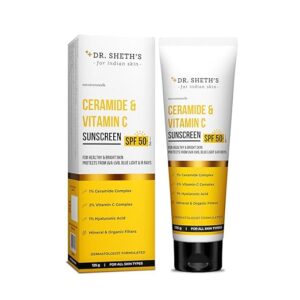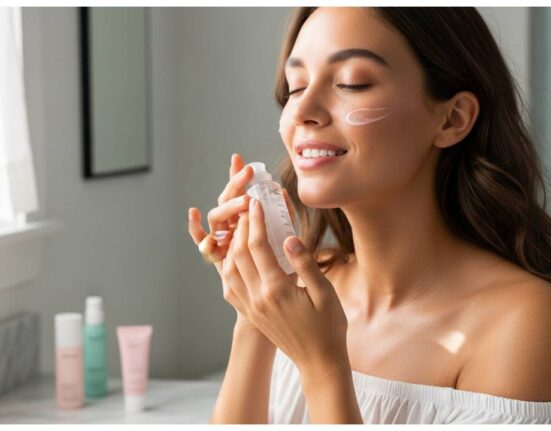The summer season brings with it a unique set of challenges for our skin. Increased temperatures, humidity, and sun exposure can lead to a host of issues, from excessive oiliness and breakouts to sunburn and dehydration. Crafting a well-rounded summer skincare routine is paramount to maintaining healthy, radiant skin throughout these months. This complete guide will delve into the best summer skincare practices.
Summer is similar with sunshine, longer days, and outdoor adventures. While we embrace the warmth, our skin often bears the brunt of the season’s intensity. Elevated temperatures, soaring humidity, and powerful UV rays demand a strategic shift in our skincare approach. Neglecting to adjust your routine can lead to a cascade of common summer skin woes: think stubborn breakouts, heightened oiliness, pesky sunspots, and even premature aging.
This isn’t just about slapping on some sunscreen it’s about a holistic approach that protects, repairs, and rejuvenates your skin. From understanding your skin’s unique needs in the heat to embracing powerhouse ingredients, we’ll equip you with the knowledge to maintain a luminous, healthy complexion all summer long. Get ready to unlock the secrets to a truly summer-proof glow!
Understanding Summer Skin Challenges
Before we dive into the solutions, let’s understand the culprits behind common summer skin concerns:
- Increased Sebum Production: Heat and humidity often trigger overactive sebaceous glands, leading to excess oil, shine, and clogged pores. This is particularly challenging for those with naturally oily or combination skin.
- Dehydration Despite Humidity: While the air might feel moist, increased sweating can lead to internal dehydration, which reflects on your skin as dullness, tightness, and a compromised barrier.
- Sun Damage: UVA and UVB rays are the primary cause of sunburn, hyperpigmentation (sunspots, melasma), collagen breakdown, and an increased risk of skin cancer.
- Acne and Breakouts: The combination of excess oil, sweat, and trapped impurities creates a breeding ground for acne-causing bacteria.
- Heat Rash and Prickly Heat: Blocked sweat ducts can lead to uncomfortable red bumps and itchiness, especially in humid conditions.
- Pollution Exposure: Summer activities often mean more time outdoors, exposing skin to environmental pollutants that can cause oxidative stress and premature aging.
The Core Pillars of Your Summer Skincare Arsenal
A successful summer skincare tips hinges on a few non-negotiable steps, each carefully chosen to combat the season’s specific challenges.
1. The Cleanse: Fresh Start, Every Time
In summer, a thorough yet gentle cleanse is paramount. You’re not just removing makeup; you’re washing away sweat, excess oil, sunscreen residue, and environmental pollutants that accumulate throughout the day.
- Choose Wisely: Opt for a lightweight, foaming, or gel-based cleanser. Avoid harsh, stripping formulas that can disrupt your skin’s natural barrier and ironically trigger more oil production.
- For Oily/Acne-Prone Skin: Look for ingredients like salicylic acid (BHA) to deep-clean pores, or tea tree oil for its antibacterial properties.
- For Dry/Sensitive Skin: Creamy, low-pH cleansers or micellar water can effectively cleanse without stripping essential moisture.
- Double Cleansing: Consider incorporating a double cleanse in your evening routine, especially if you wear heavy sunscreen or makeup. Start with an oil-based cleanser or balm to dissolve impurities, followed by a water-based cleanser.
- Frequency: Cleanse twice daily – morning and night. An evening cleanse is non-negotiable to remove the day’s build-up, and a morning cleanse helps refresh your skin after nighttime regeneration.
2. The Tone: Rebalancing and Prepping
Toning is often overlooked but plays a crucial role in summer skincare. A good toner helps rebalance your skin’s pH after cleansing, remove any lingering impurities, and prep your skin to better absorb subsequent products.
- Alcohol-Free is Key: Steer clear of toners with high alcohol content, as they can be excessively drying and irritating, especially in the heat.
- Beneficial Ingredients:
- Hydrating: Look for hyaluronic acid, glycerin, or rose water.
- Soothing: Chamomile, aloe vera, or green tea extracts can calm irritated skin.
- Pore-Refining (for oily skin): Witch hazel (alcohol-free), niacinamide, or very gentle AHAs (like lactic acid in low concentrations, used primarily at night).
3. The Treat: Targeted Solutions (Serums are Your Summer Superheroes)
Serums are lightweight formulas rich in active ingredients that penetrate deep into the skin to address specific concerns. In summer, they become indispensable for protection, repair, and brightening.
- Vitamin C (The Morning Must-Have): This antioxidant powerhouse is your best friend in summer. Applied in the morning, it neutralizes free radicals generated by UV radiation and pollution, brightens skin tone, fades dark spots, and boosts collagen production. Look for L-Ascorbic Acid for maximum efficacy.
- Niacinamide (Vitamin B3): A multi-tasking marvel! Niacinamide helps regulate oil production, minimize pores, strengthen the skin barrier, reduce redness and inflammation, and improve overall skin tone. It’s excellent for all skin types, particularly oily, acne-prone, and sensitive skin. Can be used morning and/or night.
- Hyaluronic Acid: Even oily skin needs hydration. Hyaluronic acid is a humectant that draws moisture from the air into your skin, providing lightweight, oil-free hydration without feeling heavy. Apply to slightly damp skin to enhance absorption and effectiveness.
- Antioxidant Serums (Beyond Vitamin C): Consider serums containing ferulic acid, Vitamin E, green tea extract, or resveratrol for added environmental protection. These work synergistically with your sunscreen.
- Lightweight Formulas: In summer, opt for gel or water-based serums that absorb quickly and don’t feel sticky.
4. The Moisturize: Lightweight Hydration is Gold
Many mistakenly believe they can skip moisturizer in summer, especially if they have oily skin. This is a common mistake! Oily skin still requires moisture to keep the skin barrier healthy and functioning properly. Skipping it can lead to dehydration, which paradoxically can trigger more oil production.
- Texture Matters: Ditch heavy creams for lightweight lotions, gel moisturizers, or oil-free fluid formulas.
- Ingredients to Look For:
- Humectants: Hyaluronic acid, glycerin, urea.
- Non-comedogenic: Ensures it won’t clog pores.
- Soothing Agents: Aloe vera, cica (centella asiatica), allantoin.
- For Oily Skin: A mattifying gel moisturizer can help control shine.
- For Dry/Dehydrated Skin: A slightly richer, yet still lightweight, lotion with ceramides can help reinforce the skin barrier.
5. The Protect: Sunscreen is Your Non-Negotiable Armor
This is the MOST critical step in your summer routine. Sunscreen is not optional; it’s essential for preventing sun damage, premature aging, and skin cancer.
- Broad-Spectrum SPF 30+ (Minimum): Always choose a broad-spectrum sunscreen that protects against both UVA (aging rays) and UVB (burning rays). An SPF of 30 blocks approximately 97% of UVB rays, while SPF 50 blocks about 98%. Higher SPF offers marginally more protection, but consistent reapplication is more important.
- Water-Resistant: If you’re sweating or swimming, opt for water-resistant formulas.
- Physical vs. Chemical:
- Physical (Mineral) Sunscreens: Contain zinc oxide and/or titanium dioxide. They sit on top of the skin and physically block UV rays. Great for sensitive skin, but can sometimes leave a white cast.
- Chemical Sunscreens: Absorb UV rays and convert them into heat. Lighter textures, often more cosmetically elegant. Choose formulas with newer filters if concerned about older generation chemical filters.
- Application is Key: Apply a generous amount (at least a teaspoon for your face and neck) as the last step in your morning routine, before makeup.
- Reapplication is CRUCIAL: Reapply every two hours, or immediately after swimming or excessive sweating. Extend your skincare to your ears, neck, chest, and hands for complete protection.
- Beyond the Bottle: Supplement sunscreen with physical protection: wide-brimmed hats, UV-protective clothing, and sunglasses. Stay in the shade when the sun is strongest—between 10 AM and 4 PM.
Adapting Your Routine for Different Skin Types
While the core pillars remain, tailoring your product choices to your specific skin type is crucial.
Summer Skincare for Oily & Acne-Prone Skin
The challenge here is to control oil and breakouts without over-drying or irritating the skin.
- Cleanser: Salicylic acid wash (morning and/or evening), or a gentle foaming cleanser.
- Toner: Alcohol-free toner with niacinamide or witch hazel.
- Serums: Niacinamide, Vitamin C, or a lightweight BHA serum.
- Moisturizer: Gel-based, oil-free, non-comedogenic moisturizer. Look for mattifying formulas.
- Sunscreen: Lightweight, non-comedogenic, gel or fluid sunscreen. Tinted mineral sunscreens can also help with shine.
- Extra Tip: Clay masks 1-2 times a week can help absorb excess oil and purify pores.
Summer Skincare for Dry & Dehydrated Skin
Even dry skin can feel greasy in summer due to increased sweat, but it still needs deep hydration.
- Cleanser: Creamy, hydrating cleanser that doesn’t strip moisture.
- Toner: Choose a hydrating formula with hyaluronic acid or soothing rose water.
- Serums: Hyaluronic acid, ceramides, or a hydrating Vitamin C serum.
- Moisturizer: Lightweight lotion or fluid with humectants and emollients.
- Sunscreen: Hydrating sunscreen that provides a dewy finish.
- Extra Tip: A hydrating mist throughout the day can provide a refreshing boost.
Summer Skincare for Combination Skin
This type requires a balanced approach, often treating different areas of the face differently.
- Cleanser: Gentle foaming or gel cleanser.
- Toner: Hydrating or balancing toner.
- Serums: Niacinamide is excellent for balancing oil and dryness. You might use a Vitamin C serum in the T-zone and a hydrating serum on drier areas.
- Moisturizer: A lightweight gel-cream that provides adequate hydration without feeling heavy. You might use a slightly richer formula on drier cheeks and a lighter one on the T-zone.
- Sunscreen: A lightweight, broad-spectrum sunscreen that offers good protection without exacerbating oiliness or dryness.
Summer Skincare for Sensitive Skin
Minimizing irritation and redness is the priority.
- Cleanser: Extremely gentle, fragrance-free, low-pH cleanser.
- Toner: Soothing, alcohol-free toner with ingredients like aloe vera or chamomile.
- Serums: Niacinamide, cica (Centella Asiatica), or calming antioxidant serums. Avoid strong actives.
- Moisturizer: Fragrance-free, hypoallergenic, barrier-repairing lotion.
- Sunscreen: Mineral (physical) sunscreen with zinc oxide and titanium dioxide is generally preferred as it’s less likely to irritate.
- Extra Tip: Patch test new products. Keep your routine minimalist.
Summer Skincare for Mature Skin
Focus on protection, hydration, and supporting collagen production.
- Cleanser: Hydrating, gentle cleanser.
- Toner: Hydrating and antioxidant-rich toner.
- Serums: Vitamin C (for collagen and brightening), hyaluronic acid, and peptide serums. Consider a bakuchiol serum as a gentler alternative to retinol in summer.
- Moisturizer: A slightly richer, yet still non-heavy, moisturizer with ceramides, peptides, and antioxidants.
- Sunscreen: Daily broad-spectrum SPF 50, preferably with added antioxidants.
- Extra Tip: Don’t forget your neck, chest, and hands – they show signs of aging too!
Beyond the Daily Routine: Essential Summer Skincare Habits
Your daily routine is the foundation, but these additional habits will supercharge your summer skin health:
- Exfoliation (Gentle is Best): In summer, dead skin cells, sweat, and oil can build up faster, leading to dullness and clogged pores.
- Chemical Exfoliants: AHAs (like lactic acid) or BHAs (salicylic acid) are often preferred over harsh physical scrubs. Use them 1-2 times a week, preferably at night, and ensure diligent sunscreen use as they can increase sun sensitivity.
- Frequency: Reduce the frequency compared to winter. Over-exfoliation can compromise your skin barrier.
- Masking: Incorporate masks that address summer-specific concerns.
- Clay Masks: For oily/acne-prone skin to draw out impurities and control shine.
- Hydrating Sheet Masks: For a quick boost of moisture after sun exposure.
- Soothing Masks: With aloe vera or cica to calm irritated skin.
- Post-Sun Care: Even with diligent sunscreen, some sun exposure is inevitable.
- Cooling Gels: Aloe vera gel or formulations with cucumber and menthol can provide immediate relief.
- Hydrating Lotions: Replenish lost moisture and help prevent peeling.
- Antioxidant Serums: After sun exposure, antioxidants can help mitigate free radical damage.
- Internal Hydration: Drink plenty of water throughout the day. Your skin reflects your internal hydration levels.
- Healthy Diet: Incorporate antioxidant-rich fruits and vegetables (berries, leafy greens) to provide internal protection against oxidative stress. Omega-3 fatty acids found in fish or flaxseeds also support skin health.
- Shower Immediately After Sweating: Don’t let sweat linger on your skin, especially if you’re prone to body acne or heat rash.
- Clean Pillowcases and Towels: Change them frequently to prevent bacterial buildup.
Don’t Forget Your Body: Extend your summer skincare principles to your body. Use a lightweight, hydrating body lotion and apply sunscreen liberally to all exposed areas.
Common Summer Skincare Mistakes to Avoid
- Skipping Sunscreen: The most egregious error. Even on cloudy days or indoors near windows, UV rays can penetrate.
- Over-Exfoliating: Can lead to a compromised skin barrier, increased sensitivity, and sun damage.
- Using Heavy Products: Rich creams and oils can feel suffocating and contribute to breakouts in hot, humid weather.
- Not Reapplying Sunscreen: A single morning application won’t protect you all day.
- Ignoring Hydration: Thinking oily skin doesn’t need moisturizer is a big myth.
- Hot Showers: Hot water can strip your skin’s natural oils, leading to dryness and irritation. Opt for lukewarm showers.
- Picking at Breakouts: This can lead to inflammation, scarring, and post-inflammatory hyperpigmentation, which is exacerbated by sun exposure.
Crafting Your Personalized Summer Skincare Routine
Crafting Your Personalized Summer Skincare Routine
Building the perfect summer routine is an ongoing process of observation and adjustment. Notice how your skin reacts to various products and changes in the environment.
A Sample Day & Night Routine:
Morning:
- Cleanse: Gentle foaming or gel cleanser.
- Tone: Hydrating or balancing toner.
- Serum: Vitamin C serum (antioxidant protection) or Niacinamide serum.
- Moisturize: Lightweight, non-comedogenic moisturizer.
- Protect: Broad-spectrum SPF 30+ (or 50+) sunscreen.
Evening:
- Double Cleanse (Optional but recommended): Oil-based cleanser/balm, followed by a water-based cleanser.
- Tone: Hydrating or soothing toner.
- Treatment Serum: Niacinamide, Hyaluronic Acid, or a gentle exfoliating serum (1-2 times/week).
- Moisturize: Lightweight, hydrating moisturizer.
Summer skincare isn’t just about protection; it’s about empowerment. By understanding the unique demands the season places on your skin and implementing a thoughtful, targeted routine, you can step out with confidence, embracing the sunshine while maintaining a healthy, radiant complexion. Remember, consistency is key, and listening to your skin’s needs will always lead to the best results. Invest in your skin this summer, and it will thank you with a luminous, happy glow that lasts all season long.
Frequently Asked Questions
A1: Increased heat and humidity in summer stimulate your sebaceous glands to produce more sebum (oil) as a natural response to keep your skin hydrated and protected. This often leads to a greasier feeling, especially in humid climates like India. Even dry skin types can experience this increased oiliness.
A2: Absolutely not! This is a common myth. While your skin might feel oilier, it can still become dehydrated due to sweating, sun exposure, and air conditioning. Skipping moisturizer can actually trigger your skin to produce more oil to compensate for the lack of moisture, leading to breakouts and an imbalanced complexion. Opt for a lightweight, gel-based, or water-based moisturizer that provides hydration without feeling heavy or clogging pores.
A3: Sunscreen should be reapplied every two hours, or more frequently if you are swimming, sweating heavily, or towel-drying. Even on cloudy days, UV rays can penetrate and cause damage. In the intense Indian summer sun, consistent reapplication is crucial for effective protection.
A4: Yes! UVA rays, which contribute to premature aging and hyperpigmentation, can penetrate through windows. So, if you're spending extended periods near a window, whether at home or in the office, it's wise to apply sunscreen.
A5: For daily use, a broad-spectrum sunscreen with an SPF of 30 or higher is generally recommended. For prolonged outdoor activities, especially in direct sunlight, SPF 50+ offers enhanced protection. Always choose a "broad-spectrum" formula to protect against both UVA (aging) and UVB (burning) rays.
A6: No, this is a dangerous myth. A tan is a sign of skin damage caused by UV radiation. It indicates that your skin cells have been harmed, increasing your risk of premature aging, sunspots, and skin cancer. There's no such thing as a "healthy tan" from sun exposure.
A7: Increased sweat, oil, and humidity can lead to clogged pores and breakouts. Focus on:
Gentle Cleansing: Cleanse your face twice daily with a mild, gel-based cleanser to remove impurities without stripping natural oils.
Lightweight Products: Switch to non-comedogenic (non-pore-clogging) serums and moisturizers.
Targeted Treatments: Incorporate ingredients like salicylic acid or niacinamide to help control oil and prevent breakouts.
Avoid Heavy Makeup: Opt for a minimal makeup routine to let your skin breathe.



